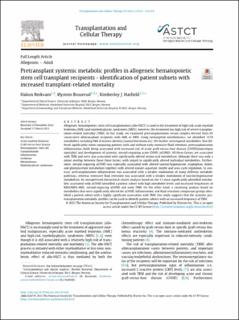| dc.contributor.author | Reikvam, Håkon | |
| dc.contributor.author | Bruserud, Øystein | |
| dc.contributor.author | Hatfield, Kimberley Joanne | |
| dc.date.accessioned | 2023-10-12T12:53:10Z | |
| dc.date.available | 2023-10-12T12:53:10Z | |
| dc.date.created | 2023-06-21T10:19:12Z | |
| dc.date.issued | 2023 | |
| dc.identifier.issn | 2666-6375 | |
| dc.identifier.uri | https://hdl.handle.net/11250/3096153 | |
| dc.description.abstract | Allogeneic hematopoietic stem cell transplantation (allo-HSCT) is used in the treatment of high-risk acute myeloid leukemia (AML) and myelodysplastic syndromes (MDS); however, the treatment has high risk of severe transplantation-related mortality (TRM). In this study, we examined pretransplantation serum samples derived from 92 consecutive allotransplant recipients with AML or MDS. Using nontargeted metabolomics, we identified 1274 metabolites including 968 of known identity (named biochemicals). We further investigated metabolites that differed significantly when comparing patients with and without early extensive fluid retention, pretransplantation inflammation (both being associated with increased risk of acute graft-versus-host disease [GVHD]/nonrelapse mortality) and development of systemic steroid-requiring acute GVHD (aGVHD). All three factors are associated with TRM and were also associated with significantly altered amino acid metabolism, although there was only a minor overlap between these three factors with regard to significantly altered individual metabolites. Furthermore, steroid-requiring aGVHD was especially associated with altered taurine/hypotaurine, tryptophan, biotin, and phenylacetate metabolism together with altered malate-aspartate shuttle and urea cycle regulation. In contrast, pretransplantation inflammation was associated with a weaker modulation of many different metabolic pathways, whereas extensive fluid retention was associated with a weaker modulation of taurine/hypotaurine metabolism. An unsupervised hierarchical cluster analysis based on the 13 most significantly identified metabolites associated with aGVHD identified a patient subset with high metabolite levels and increased frequencies of MDS/MDS-AML, steroid-requiring aGVHD and early TRM. On the other hand, a clustering analysis based on metabolites that were significantly altered for aGVHD, inflammation, and fluid retention comparison groups identified a patient subset with a highly significant association with TRM. Our study suggests that the systemic pretransplantation metabolic profiles can be used to identify patient subsets with an increased frequency of TRM. | en_US |
| dc.language.iso | eng | en_US |
| dc.publisher | Elsevier | en_US |
| dc.rights | Navngivelse 4.0 Internasjonal | * |
| dc.rights.uri | http://creativecommons.org/licenses/by/4.0/deed.no | * |
| dc.title | Pretransplant systemic metabolic profiles in allogeneic hematopoietic stem cell transplant recipients - identification of patient subsets with increased transplant-related mortality | en_US |
| dc.type | Journal article | en_US |
| dc.type | Peer reviewed | en_US |
| dc.description.version | publishedVersion | en_US |
| dc.rights.holder | Copyright 2023 the authors | en_US |
| cristin.ispublished | true | |
| cristin.fulltext | original | |
| cristin.qualitycode | 1 | |
| dc.identifier.doi | 10.1016/j.jtct.2023.03.020 | |
| dc.identifier.cristin | 2156463 | |
| dc.source.journal | Transplantation and Cellular Therapy (TCT) | en_US |
| dc.source.pagenumber | 375.e1-375.e14 | en_US |
| dc.identifier.citation | Transplantation and Cellular Therapy (TCT). 2023, 29 (6), 375.e1-375.e14. | en_US |
| dc.source.volume | 29 | en_US |
| dc.source.issue | 6 | en_US |

